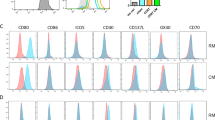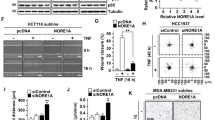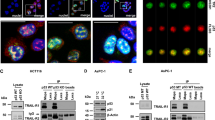Abstract
Mucosa-associated lymphoid tissue (MALT) lymphomais the most common extranodal lymphoid neoplasm. Chromosomal translocation t(11;18)(q21,q21) is found in 30% of gastric MALT lymphomas and is associated with a failure to respond to standard treatment and a tendency to disseminate. This translocation generates a chimeric protein composed of N-terminal sequences of Inhibitor of Apoptosis 2 (API2, also known as BIRC3 and cIAP2) fused to C-terminal sequences of MALT1. API2-MALT1 promotes cell survival and proliferation via activation of nuclear factor-κB (NF-κB). Here, we investigate the mechanism by which the API2 moiety contributes to NF-κB stimulation. We find that the API2 moiety mediates oligomerization of API2-MALT1 as well as interaction with tumor necrosis factor receptor-associated factor 2 (TRAF2). Surprisingly, oligomerization does not occur via homotypic interaction; rather, the API2 moiety of one monomer interacts with the MALT1 moiety of another monomer. Further, the specific region of the API2 moiety responsible for mediating oligomerization is distinct from that mediating TRAF2 binding. Although deletion or mutation of the TRAF2 binding site does not inhibit oligomerization, it does lead to dramatically decreased NF-κB activation. Deletion of both TRAF2 binding and oligomerization regions results in near-complete loss of NF-κB activation. Thus, API2 moiety-mediated heterotypic oligomerization and TRAF2 binding both contribute to maximal API2-MALT1-dependent NF-κB stimulation.
This is a preview of subscription content, access via your institution
Access options
Subscribe to this journal
Receive 50 print issues and online access
$259.00 per year
only $5.18 per issue
Buy this article
- Purchase on Springer Link
- Instant access to full article PDF
Prices may be subject to local taxes which are calculated during checkout






Similar content being viewed by others
References
Akagi T, Motegi M, Tamura A, Suzuki R, Hosokawa Y, Suzuki H et al. (1999). A novel gene, MALT1 at 18q21, is involved in t(11;18) (q21;q21) found in low-grade B-cell lymphoma of mucosa-associated lymphoid tissue. Oncogene 18: 5785–5794.
Baens M, Fevery S, Sagaert X, Noels H, Hagens S, Broeckx V et al. (2006). Selective expansion of marginal zone B cells in Emicro-API2-MALT1 mice is linked to enhanced IkappaB kinase gamma polyubiquitination. Cancer Res 66: 5270–5277.
Bishop GA . (2004). The multifaceted roles of TRAFs in the regulation of B-cell function. Nat Rev Immunol 4: 775–786.
Deveraux QL, Reed JC . (1999). IAP family proteins – suppressors of apoptosis. Genes Dev 13: 239–252.
Dierlamm J, Baens M, Wlodarska I, Stefanova-Ouzounova M, Hernandez JM, Hossfeld DK et al. (1999). The apoptosis inhibitor gene API2 and a novel 18q gene, MLT, are recurrently rearranged in the t(11;18)(q21;q21)p6 associated with mucosa-associated lymphoid tissue lymphomas. Blood 93: 3601–3609.
Dong W, Liu Y, Peng J, Chen L, Zou T, Xiao H et al. (2006). The IRAK-1-BCL10-MALT1-TRAF6-TAK1 cascade mediates signaling to NF-kappa B from toll-like receptor 4. J Biol Chem 281: 26029–26040.
Ho L, Davis RE, Conne B, Chappuis R, Berczy M, Mhawech P et al. (2005). MALT1 and the API2-MALT1 fusion act between CD40 and IKK and confer NF-kappa B-dependent proliferative advantage and resistance against FAS-induced cell death in B cells. Blood 105: 2891–2899.
Hosokawa Y, Suzuki H, Suzuki Y, Takahashi R, Seto M . (2004). Antiapoptotic function of apoptosis inhibitor 2-MALT1 fusion protein involved in t(11;18)(q21;q21) mucosa-associated lymphoid tissue lymphoma. Cancer Res 64: 3452–3457.
Hostager BS, Haxhinasto SA, Rowland SL, Bishop GA . (2003). Tumor necrosis factor receptor-associated factor 2 (TRAF2)-deficient B lymphocytes reveal novel roles for TRAF2 in CD40 signaling. J Biol Chem 278: 45382–45390.
Hu S, Du MQ, Park SM, Alcivar A, Qu L, Gupta S et al. (2006). cIAP2 is a ubiquitin protein ligase for BCL10 and is dysregulated in mucosa-associated lymphoid tissue lymphomas. J Clin Invest 116: 174–181.
Inagaki H, Nakamura T, Li C, Sugiyama T, Asaka M, Kodaira J et al. (2004). Gastric MALT lymphomas are divided into three groups based on responsiveness to Helicobacter pylori eradication and detection of API2-MALT1 fusion. Am J Surg Pathol 28: 1560–1567.
Isaacson PG . (1999). Mucosa-associated lymphoid tissue lymphoma. Semin Hematol 36: 139–147.
Isaacson PG, Du MQ . (2004). MALT lymphoma: from morphology to molecules. Nat Rev Cancer 4: 644–653.
Iwano M, Okazaki K, Uchida K, Nakase H, Ohana M, Matsushima Y et al. (2004). Characteristics of gastric B-cell lymphoma of mucosa-associated lymphoid tissue type involving multiple organs. J Gastroenterol 39: 739–746.
Levy M, Copie-Bergman C, Gameiro C, Chaumette MT, Delfau-Larue MH, Haioun C et al. (2005). Prognostic value of translocation t(11;18) in tumoral response of low-grade gastric lymphoma of mucosa-associated lymphoid tissue type to oral chemotherapy. J Clin Oncol 23: 5061–5066.
Liu H, Ruskon-Fourmestraux A, Lavergne-Slove A, Ye H, Molina T, Bouhnik Y et al. (2001a). Resistance of t(11;18) positive gastric mucosa-associated lymphoid tissue lymphoma to Helicobacter pylori eradication therapy. Lancet 357: 39–40.
Liu H, Ye H, Dogan A, Ranaldi R, Hamoudi RA, Bearzi I et al. (2001b). T(11;18)(q21;q21) is associated with advanced mucosa-associated lymphoid tissue lymphoma that expresses nuclear BCL10. Blood 98: 1182–1187.
Liu H, Ye H, Ruskone-Fourmestraux A, De Jong D, Pileri S, Thiede C et al. (2002). T(11;18) is a marker for all stage gastric MALT lymphomas that will not respond to H. pylori eradication. Gastroenterology 122: 1286–1294.
Lucas PC, McAllister-Lucas LM, Nunez G . (2004). NF-kappaB signaling in lymphocytes: a new cast of characters. J Cell Sci 117: 31–39.
Lucas PC, Yonezumi M, Inohara N, McAllister-Lucas LM, Abazeed ME, Chen FF et al. (2001). Bcl10 and MALT1, independent targets of chromosomal translocation in malt lymphoma, cooperate in a novel NF-kappa B signaling pathway. J Biol Chem 276: 19012–19019.
Luque LE, Grape KP, Junker M . (2002). A highly conserved arginine is critical for the functional folding of inhibitor of apoptosis (IAP) BIR domains. Biochemistry 41: 13663–13671.
McAllister-Lucas LM, Inohara N, Lucas PC, Ruland J, Benito A, Li Q et al. (2001). Bimp1, a MAGUK family member linking protein kinase C activation to Bcl10-mediated NF-kappaB induction. J Biol Chem 276: 30589–30597.
Morgan JA, Yin Y, Borowsky AD, Kuo F, Nourmand N, Koontz JI et al. (1999). Breakpoints of the t(11;18)(q21;q21) in mucosa-associated lymphoid tissue (MALT) lymphoma lie within or near the previously undescribed gene MALT1 in chromosome 18. Cancer Res 59: 6205–6213.
Murga Penas EM, Hinz K, Roser K, Copie-Bergman C, Wlodarska I, Marynen P et al. (2003). Translocations t(11;18)(q21;q21) and t(14;18)(q32;q21) are the main chromosomal abnormalities involving MLT/MALT1 in MALT lymphomas. Leukemia 17: 2225–2229.
Okabe M, Inagaki H, Ohshima K, Yoshino T, Li C, Eimoto T et al. (2003). API2-MALT1 fusion defines a distinctive clinicopathologic subtype in pulmonary extranodal marginal zone B-cell lymphoma of mucosa-associated lymphoid tissue. Am J Pathol 162: 1113–1122.
Remstein ED, James CD, Kurtin PJ . (2000). Incidence and subtype specificity of API2-MALT1 fusion translocations in extranodal, nodal, and splenic marginal zone lymphomas. Am J Pathol 156: 1183–1188.
Rothe M, Pan MG, Henzel WJ, Ayres TM, Goeddel DV . (1995). The TNFR2-TRAF signaling complex contains two novel proteins related to baculoviral inhibitor of apoptosis proteins. Cell 83: 1243–1252.
Ruland J, Duncan GS, Wakeham A, Mak TW . (2003). Differential requirement for Malt1 in T and B cell antigen receptor signaling. Immunity 19: 749–758.
Sakugawa ST, Yoshino T, Nakamura S, Inagaki H, Sadahira Y, Nakamine H et al. (2003). API2-MALT1 fusion gene in colorectal lymphoma. Mod Pathol 16: 1232–1241.
Salvesen GS, Duckett CS . (2002). IAP proteins: blocking the road to death's door. Nat Rev Mol Cell Biol 3: 401–410.
Samuel T, Welsh K, Lober T, Togo SH, Zapata JM, Reed JC . (2006). Distinct BIR domains of cIAP1 mediate binding to and ubiquitination of tumor necrosis factor receptor-associated factor 2 and second mitochondrial activator of caspases. J Biol Chem 281: 1080–1090.
Senyuk V, Li D, Zakharov A, Mikhail FM, Nucifora G . (2005). The distal zinc finger domain of AML1/MDS1/EVI1 is an oligomerization domain involved in induction of hematopoietic differentiation defects in primary cells in vitro. Cancer Res 65: 7603–7611.
So CW, Cleary ML . (2004). Dimerization: a versatile switch for oncogenesis. Blood 104: 919–922.
Stoffel A, Chaurushiya M, Singh B, Levine AJ . (2004). Activation of NF-kappaB and inhibition of p53-mediated apoptosis by API2/mucosa-associated lymphoid tissue 1 fusions promote oncogenesis. Proc Natl Acad Sci USA 101: 9079–9084.
Streubel B, Lamprecht A, Dierlamm J, Cerroni L, Stolte M, Ott G et al. (2003). T(14;18)(q32;q21) involving IGH and MALT1 is a frequent chromosomal aberration in MALT lymphoma. Blood 101: 2335–2339.
Sun L, Deng L, Ea CK, Xia ZP, Chen ZJ . (2004). The TRAF6 ubiquitin ligase and TAK1 kinase mediate IKK activation by BCL10 and MALT1 in T lymphocytes. Mol Cell 14: 289–301.
Turner SD, Alexander DR . (2006). Fusion tyrosine kinase mediated signalling pathways in the transformation of haematopoietic cells. Leukemia 20: 572–582.
Uren AG, O'Rourke K, Aravind LA, Pisabarro MT, Seshagiri S, Koonin EV et al. (2000). Identification of paracaspases and metacaspases: two ancient families of caspase-like proteins, one of which plays a key role in MALT lymphoma. Mol Cell 6: 961–967.
Varfolomeev E, Wayson SM, Dixit VM, Fairbrother WJ, Vucic D . (2006). The inhibitor of apoptosis protein fusion c-IAP2/MALT1 stimulates NF-kappa B activation independently of TRAF1 and TRAF2. J Biol Chem 281: 29022–29029.
Wang D, You Y, Case SM, McAllister-Lucas LM, Wang L, DiStefano PS et al. (2002). A requirement for CARMA1 in TCR-induced NF-kappa B activation. Nat Immunol 3: 830–835.
Willis TG, Jadayel DM, Du MQ, Peng H, Perry AR, Abdul-Rauf M et al. (1999). Bcl10 is involved in t(1;14)(p22;q32) of MALT B cell lymphoma and mutated in multiple tumor types. Cell 96: 35–45.
Wright CW, Duckett CS . (2005). Reawakening the cellular death program in neoplasia through the therapeutic blockade of IAP function. J Clin Invest 115: 2673–2678.
Ye H, Liu H, Raderer M, Chott A, Ruskone-Fourmestraux A, Wotherspoon A et al. (2003). High incidence of t(11;18)(q21;q21) in Helicobacter pylori-negative gastric MALT lymphoma. Blood 101: 2547–2550.
Zhang Q, Siebert R, Yan M, Hinzmann B, Cui X, Xue L et al. (1999). Inactivating mutations and overexpression of BCL10, a caspase recruitment domain-containing gene, in MALT lymphoma with t(1;14)(p22;q32). Nat Genet 22: 63–68.
Zhou H, Du MQ, Dixit VM . (2005). Constitutive NF-kappaB activation by the t(11;18)(q21;q21) product in MALT lymphoma is linked to deregulated ubiquitin ligase activity. Cancer Cell 7: 425–431.
Zhou H, Wertz I, O'Rourke K, Ultsch M, Seshagiri S, Eby M et al. (2004). Bcl10 activates the NF-kappaB pathway through ubiquitination of NEMO. Nature 427: 167–171.
Zucca E, Bertoni F, Roggero E, Cavalli F . (2000). The gastric marginal zone B-cell lymphoma of MALT type. Blood 96: 410–419.
Acknowledgements
We thank Dr Gabriel Nunez for helpful discussion and valuable reagents. PCL and LMML are recipients of NIH KO8 awards (5KO8 CA097986 and 5KO8 CA094920, respectively). LMML is also a recipient of a Doris Duke Clinical Scientist Development Award. This project was partially supported by a grant from the Children's Health Research Center (CHRC) and the Shirley K Schlafer Foundation.
Author information
Authors and Affiliations
Corresponding author
Additional information
Supplementary Information accompanies the paper on the Oncogene website (http://www.nature.com/onc).
Supplementary information
Rights and permissions
About this article
Cite this article
Lucas, P., Kuffa, P., Gu, S. et al. A dual role for the API2 moiety in API2-MALT1-dependent NF-κB activation: heterotypic oligomerization and TRAF2 recruitment. Oncogene 26, 5643–5654 (2007). https://doi.org/10.1038/sj.onc.1210342
Received:
Revised:
Accepted:
Published:
Issue Date:
DOI: https://doi.org/10.1038/sj.onc.1210342
Keywords
This article is cited by
-
Mucosa-associated lymphoid tissue lymphoma with t(11;18)(q21;q21) translocation: long-term follow-up results
Annals of Hematology (2019)
-
First-line antibiotic therapy in Helicobacter pylori-negative low-grade gastric mucosa-associated lymphoid tissue lymphoma
Scientific Reports (2017)
-
Molecular pathogenesis of lymphomas of mucosa-associated lymphoid tissue—from (auto)antigen driven selection to the activation of NF-κB signaling
Science China Life Sciences (2015)
-
The API2–MALT1 fusion exploits TNFR pathway-associated RIP1 ubiquitination to promote oncogenic NF-κB signaling
Oncogene (2014)
-
Mechanisms and consequences of constitutive NF-κB activation in B-cell lymphoid malignancies
Oncogene (2014)



